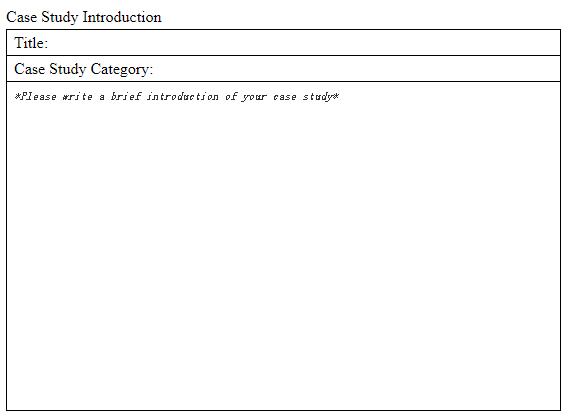Writing Standards of Global Solicitation on Best Poverty Reduction Practices (Second Call)
China.org.cn/Chinagate.cn,October 15, 2019 Adjust font size:
Writing Standards of Global Solicitation
on Best Poverty Reduction Practices (Second Call)
I. Content and Copyright Requirements:
①Applicants have to be the original author of the submitted case studies and hold copyright of the case study.
②Individual authors of selected case studies must share their copyright of the case study with GPIG. GPIG has the usage right of the case study, can edit and modify the case study according to its writing standards, and upload it to the database for readers to view and download for free. Moreover, GPIG and its partner organizations can use the case studies in non-profit promotional activities for free. Names of authors will be published along with respective case studies.
II. Selecting Criteria:
Participating case studies should demonstrate specific solutions to a targeted poverty-stricken group in a certain context. Programs in the case study should be successful, and even worth to be replicated and promoted in other contexts and demographics. Eligible case studies must meet the following requirements:
Targeted: Demonstrate a specific solution to a certain problem;
Relevant: Focus specifically on poverty reduction;
Effective: Be proved effective by practice;
Precise: Clearly and precisely reflect its solutions.
The organizers will give priority to the case studies with the following characteristics:
Replicable: Have the potential to be replicated in other contexts and demographics with an affordable cost;
Innovative: Have used new technologies or adopted an innovative method to combat poverty;
Environment friendly: Do not harm the local natural environment and traditional way of life in the process of its implementation, and are coincide with the natural and social environment;
Sustainable: Be sustainable in economy, social and environment, and should have long-lasting effects;
Broadly participated: In addition to the executing organizations, all partners including the government, private sector, academics, NGOs also contribute to the project;
Protect vulnerable groups: Women, children, the elderly, people with disabilities and indigenous people also benefit from the project.
The organizers will score the submissions according to the above standards, and make the final selection.
III. Compiling Standards:
The submission should comply with the following format, not less than 5,000 words, and contain the following eight components: Title, Abstract, Background, Interventions, Results, True story (optional), Lessons learned, and Photos (optional). Detailed requirements are as follows:
1. Title:
The title should reflect the project and its model.
2. Abstract (about 300 words):
The abstract should provide the basic information of the case study, and briefly introduce the measures and their effect.
Basic information:
Use 1 to 2 sentences to introduce the implementation and supporting organizations, location, beneficiaries, and other important matters.
Measures:
Explain the implementation of the project in a logical order, for example, phase by phase, by beneficiary groups.
Results:
Data, summary and other methods are encouraged to show the project effect.
3. Background (500 to 1,000 words):
Introduce the local context before the project implementation, and challenges for the project.
Challenges:
The natural, economic, social and other causes to the challenge.
Impact of these challenges:
For example, negative impacts on economic development, people’s livelihood, productivity, and vulnerable groups.
4. Interventions (2,000 to 3,000 words):
This is the main body of the case study. In order to make it easier for readers to understand, it is suggested to describe the case in top-down structure. Important technical details are also needed.
The mechanism and implementation process can be illustrated by flow charts, mind maps, Gantt Charts and other diagrams.
The case studies must demonstrate how the measures solve the stated challenges.
All requirements before the project implementation, including fund, personnel, and technology.
What the government and other partners contributed to the project implementation, and their practice in detail.
Reflect the relevance between the case study and the theme. Emphasis the highlights of the case study, such as efforts to empower women, protect the environment, promote inclusive finance, and narrow the information gap.
5. Results (1,000 to 1,500 words):
The economic, social, environmental and other benefits brought by the project. Charts and data are encouraged.
From the angle of the implementation organization: include implementation status and cost control status;
From the perspective of the beneficiaries: include income increase, improvement of living standards, production conditions, and self-development capacity;
Estimation on the sustainability of the project;
Benefits to special groups.
6. Lessons learned (1,000 to 1,500 words):
Mainly include analysis of favorable and unfavorable factors, summary of project mechanism, lessons learnt, and other elements.
The innovative practice involved in the case study in dealing with technical problems and creating benefit affiliating mechanisms.
7. True story (optional, 100 to 200 words)
Share a typical story in the project, showing the changes after implementing the project, such as the income comparison of the person involved.
8. Photos (optional, 5 to 8 photos)
Should be highly relevant to the case study, for better explain the content of the case study.
High-quality photos should be used, with captions and sources included.
The photos should be included in a separate folder and submitted with the case study.
Photos with copyright problems will not be used.
Annex 2:
Global Solicitation on Best Poverty Reduction Practices
(Second Call)
Application Form
Submit as an
0 Individual Author
0 Organization
Contact Information
Name _________________________
(Please leave a contact name for organization submissions)
Country ___________________ Tel ______________________
Email ______________________________

Declaration of Originality
This case study is an original report of research work conducted by either the individual applicant or the organization. I confirm that appropriate credit has been given within this thesis where reference has been made to the work of others.
Signature ______________ Date _______________